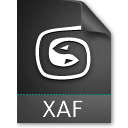.XAF File Extension

3ds Max XML Animation File
| Developer | Autodesk |
| Popularity | |
| Category | 3D Image Files |
| Format | .XAF |
| Cross Platform | Update Soon |
What is an XAF file?
Files with the .XAF extension are a unique and specialized file format used for a variety of purposes. In this article, we will explore the origin, history, technical specifications, advantages, and disadvantages of .XAF files. Additionally, we will provide instructions on how to open and convert these files on different operating systems.
More Information.
.XAF files were first introduced in the late 20th century as a means to streamline software distribution and ensure that all required assets were bundled together.
They were especially popular in the video game industry, where game developers packaged game assets, such as textures, models, and sound files, into a single .XAF file.
This simplified the distribution process and enhanced the user experience.
Origin Of This File.
The .XAF file format originated in the world of software development. It was initially created to serve as a container for various digital assets and resources used by software applications.
These files can include graphics, audio, and other essential components needed for applications to function correctly.
File Structure Technical Specification.
.XAF files have a specific structure and technical specifications. They typically consist of a header section, metadata, and the actual data payload. The header contains information about the file, such as the version and the type of data it contains.
The metadata section stores information about each asset within the file, including their file names and sizes. The data payload holds the binary content of the assets.
How to Convert the File?
Converting .XAF files to a different format may be necessary if you want to access the individual assets within them.
Here are instructions for opening .XAF files on various operating systems:
Windows:
- Using a Software Application:
- Find and install a software application that supports .XAF files on your Windows computer. Check for compatibility with your specific .XAF file version.
- Open the software application.
- Use the application’s built-in functionality to open, import, or convert the .XAF file into a different format, if needed.
Linux:
- Using Compatibility Layers:
- Linux users can use compatibility layers like Wine to run Windows applications on their system.
- Install Wine using your Linux distribution’s package manager.
- Download and install the Windows software that supports .XAF files via Wine.
- Open the Windows software using Wine, and follow the same steps as in the Windows section to convert the .XAF file.
Mac:
- Using Emulation or Virtual Machine:
- On macOS, you can use virtualization software like Parallels Desktop, VirtualBox, or VMware Fusion to run Windows applications.
- Set up a virtual machine running Windows on your Mac.
- Install the Windows software that supports .XAF files in the virtual machine.
- Open the Windows software in the virtual machine and follow the same steps as in the Windows section to convert the .XAF file.
Android:
- Using an Android App:
- Check the Google Play Store for any Android apps that claim to support .XAF files.
- Install a compatible app on your Android device.
- Open the app and use its built-in functionality to open, import, or convert the .XAF file, if supported.
iOS:
- Using iOS Workarounds:
- Due to the limited support for .XAF files on iOS, you may need to use a more complex approach.
- Explore options like cloud storage services or online converters that support .XAF files. Upload the file to a service that can convert it to a more accessible format.
- Alternatively, if there’s a specialized iOS app available for .XAF file conversion, you can install and use it. Check the App Store for any relevant applications.
Advantages And Disadvantages.
Advantages of .XAF Files:
- Efficient packaging: .XAF files allow for the efficient bundling of multiple assets into a single file, simplifying distribution and reducing the risk of missing resources.
- Data security: They can be encrypted and protected, enhancing the security of software assets.
- Fast loading times: By grouping related assets together, .XAF files can improve the loading speed of software and games.
Disadvantages of .XAF Files:
- Limited compatibility: .XAF files are not widely supported by all software and may require specific applications to open.
- Complexity: Creating and managing .XAF files can be complex, and errors in the file structure can lead to compatibility issues.
- Large file sizes: Depending on the content, .XAF files can become quite large, which may not be ideal for all distribution methods.
How to Open XAF?
Open In Windows
- Use a compatible software application for Windows that supports .XAF files.
- Open the application and use the “File” menu to import or open the .XAF file.
Open In Linux
- Linux users may need to use Wine or a similar compatibility layer to run Windows-based applications that can handle .XAF files.
- Once the application is running, follow the same steps as in the Windows section.
Open In MAC
- On macOS, use a Windows emulator or a virtual machine to run Windows software that supports .XAF files.
- Open the application and import the .XAF file as described in the Windows section.
Open In Android
- Check if there are any Android apps available that can handle .XAF files.
- Install the app, open it, and use the app’s file open/import feature to access the .XAF file.
Open In IOS
- iOS users may need to look for specialized apps or use a workaround to access .XAF files.
- Download an app if available, or explore other options based on the specific use case.
Open in Others
For other operating systems, the process will likely involve using compatibility layers or specialized applications that support .XAF files. Always consult the documentation of the relevant software and follow the recommended steps for file import.












